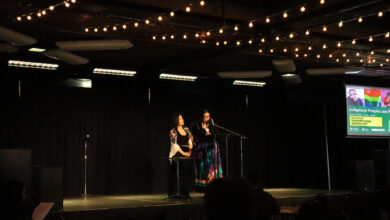Queering Zoom: students and educators say online learning must be more inclusive
Non-binary and transgender students and educators say pronoun disclosure and use needs to be normalized in online learning, a space they highlight as especially “vulnerable.”
 Rachel Narvey
Rachel NarveyAs conversations about accessibility in online learning have moved forward at the University of Alberta, ways to make Zoom more inclusive for all students are also top of the docket.
Transgender, non-binary, and gender nonconforming students and educators have highlighted how virtual learning can be made more inclusive and intentional. One of the ways they say this can be accomplished is through the normalization of pronoun disclosure and use, both during the first class when introductions are made, and in an ongoing way, through Zoom names.
Rowan Morris, a non-binary second-year elementary education student, noted how despite being encouraged to collaborate with their peers in class in Zoom chats and breakout discussions, there is a lack of emphasis on inclusion in these settings.
“There’s no stress on inclusivity from the pronoun standpoint,” they said. “I use she/her and they/them pronouns, and I’m noticing that sometimes I’m the only person in my class with those pronouns in my name. It makes me feel ostracized.”
Morris emphasized how seeking inclusion through using their pronouns in Zoom can feel like a double-edged sword.
“It kind of feels exhausting,” they said. “I want to be referred to with my personal and correct pronouns, but it sucks that I have to put myself in a position that calls attention to my identity. I don’t want to have to call attention to it, because it seems like a spectacle.”
Morris noted how attending class during the pandemic — where the privacy and refuge of home is exposed directly to the discomfort of the classroom — heightens the “vulnerability” they feel due to a lack of inclusivity in university spaces.
“I really wish that my peers and my professors would understand that it’s important to include [pronouns] within forum groups and Zoom names,” they said.
While professors often include anti-harassment and inclusionary policies in their syllabus, Morris noted that they feel these are hollow statements.
“[These professors that have these inclusion policies] don’t do the bare minimum, and aren’t putting their pronouns into their Zoom names or their emails,” they said. “It kind of feels like a slap in the face, like that was definitely just a copy and paste.”
Addressing inclusivity for LGBTQ2S+ students with top-down education
Alexandra Marshall, a rural education coordinator for the Institute for Sexual Minority Studies and Services (ISMSS), and Evan Westfal, another ISMSS education coordinator, discussed strategies that could be implemented to make online classrooms more inclusive for LGBTQ2S+ people.
“One thing I recommend is a top-down approach to education,” Westfal said. “Making sure that whoever is at the highest level of leadership is really informed about these issues, that they include their pronouns, talk about pronouns, and leave space for correction.”
Another way that Westfal said online learning could be made more inclusive for transgender, non-binary, and gender nonconforming people can start with looking at how the Zoom chat is used.
“Having some sort of norms, culture, or expectations on how the chat is used within the class is an important feature that could garner accessibility,” he said. “Since online learning is a new frontier, a lot of professors … might not have premeditated or anticipated what kind of cultural climate there will be when a presentation is online.”
Westfall noted that sometimes in online courses, the chat can become “harmful.”
“There might be a slur that is used,” he said. “If you were in a big lecture hall, generally, these things would be more noticeable and audible, but it’s easy for those things to innocuously slip into the chat.”
Marshall pointed out that issues with the chat function of video conference platforms connects to a wider change she would like to see in terms of how online learning is imagined.
“Because we’ve been thrust into this new way of teaching and learning, I think everybody involved may have a tendency to go with the flow,” she said. “There’s a certain inertia to our practices in an institution such as the university, but we have the opportunity now to examine our ways of learning and ask if we are being intentional, especially when we think about how we deal with toxicity in the classroom.”
Crafting spaces like Zoom with intention, even if virtual learning is out of necessity
Maura Roberts, a non-binary second-year political science PhD student, noted that their role as both instructor and student has been challenging to navigate in terms of gender inclusivity. Roberts echoed Marshall’s comments about intentionality.
“I think [becoming inclusive is] going to take quite a significant shift in how we intentionally craft our classroom spaces,” they said. “What’s being asked is really profound; it’s profound to honour, include, and make clear that gender self-determination is a vital part of being a human being in the world.”
Roberts pointed out that as inclusions of pronouns in email signatures have increased, they’ve noticed that there is a disconnect between these disclosures and an understanding of why they’re important to make in the first place.
“It becomes a hollow placemaker,” they said. “It does signal that maybe this person knows [why pronouns matter], but then it becomes off-putting when you find out that understanding isn’t there … you just want people to respect what you’re telling them.”
Though pronouns are just one piece of a wider picture of inclusion, for Roberts, normalizing their disclosure and use is an important step.
“Pronouns are just a small but important slice of treating people as they say they are,” they said.
Roberts also pointed out that though the normalization of pronoun disclosure and use is important, standardized use of pronouns in classrooms might make transgender and gender nonconforming students more at risk in classrooms where acceptance might be more scarce.
“If you’re having instructors who don’t believe in either transgender or gender nonconforming or non-binary students, that’s going to be a really terrible person to have your first exposure to developing and creating a trans-inclusive, non-binary inclusive and gender non conforming space,” they said.
Normalizing pronoun use without standardization
Serena Yabut, a transgender woman and Students’ Council arts councillor, noted that some transgender people might not be ready to disclose their pronouns yet.
“Some people are simply not ready to reveal their pronouns,” she said. “I’ve been there before, where I’ve just not been comfortable talking about my gender identity … [for some transgender people, pronouns] could be a really intense source of gender dysphoria.”
Yabut said while this is why she believes pronoun use should not be standardized, she would like more effort to be put into ensuring the classroom is a space where students are encouraged to share their pronouns if they so choose.
“It’s a matter of making sure that pronouns and announcing your pronouns is more normalized and less judged,” she said. “It’s about stressing safe environments where people are comfortable to share their pronouns without any hesitation.”
Yabut noted that often at the university, concerns from marginalized groups are put on the back burner.
“I find that our university, and even sometimes the Students’ Union, forgets to advocate for a safer environment for those who are often underrepresented or marginalized students of our community,” she said.
Despite this lack of action from the university, Yabut said that she also sees change on the horizon, particularly from student-led initiatives. For example, she highlighted the work of vice-president (academic) David Draper, who pushed to give students more options for choosing their pronouns when they enrol in classes and register in university.
“It’s significant that so many [young people] are helping to push for [correct pronoun use],” Yabut said.
Appearance does not dictate gender, Roberts said
Roberts highlighted how there are online spaces for transgender, non-binary, and gender nonconforming people to find community. For example, The Landing now offers a Discord for students to connect with others who identify in the same way, request one-on-one peer support, and attend programs and events.
“You can be connected to other people at the U of A to kind of just talk things through and find online pals,” they said.
Roberts concluded by pointing out that one good way to make spaces more inclusive is beginning to question assumptions about what someone’s appearance or name might say about their gender.
“You can model good practice and also affirm the people who are using pronouns other than the ones you might assume that they use,” they said. “And that could be anybody, because folks can look one million different ways.”
“Like Alok Vaid-Menon says, ‘There are as many genders as there are people on the earth.’”
UPDATE: This article was updated on July 4 at 2:53 p.m. to the article was updated to reflect the current identity of those involved.




